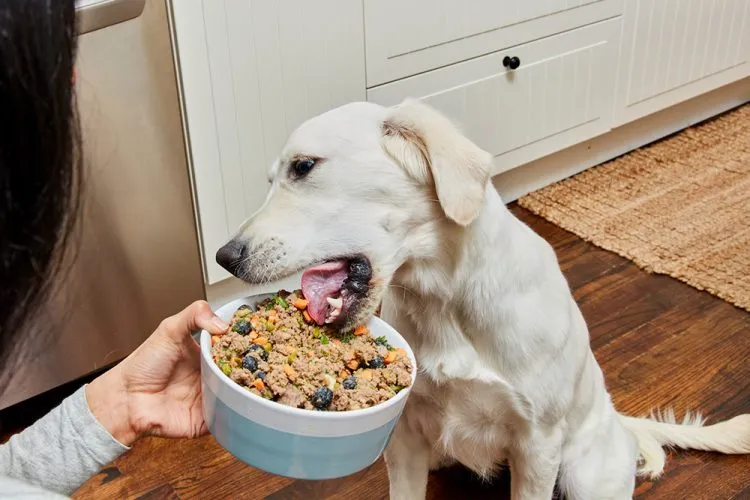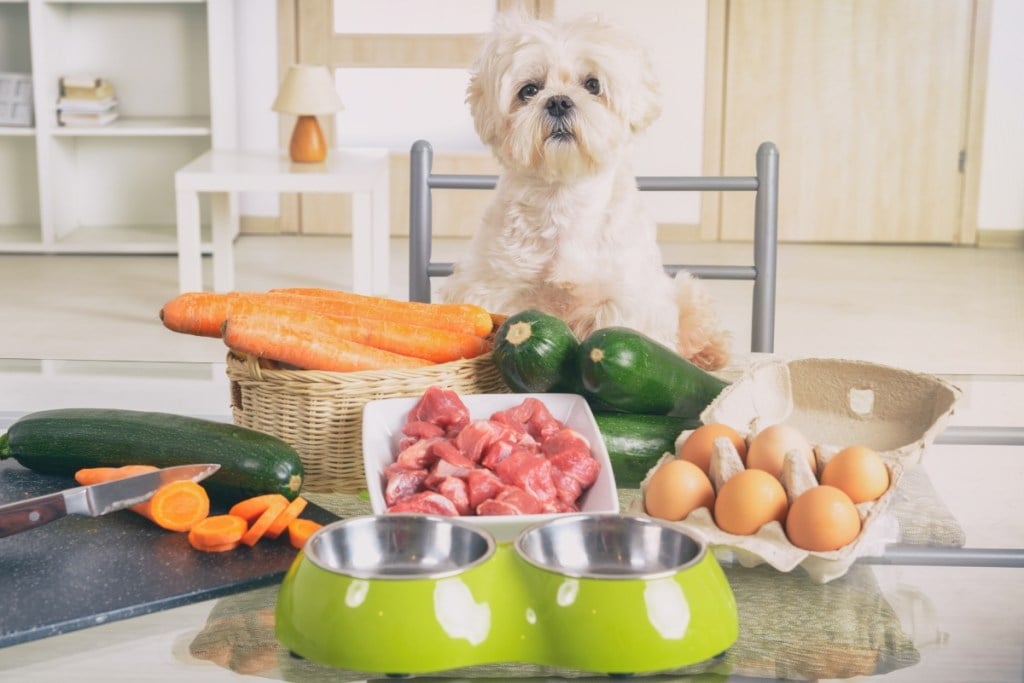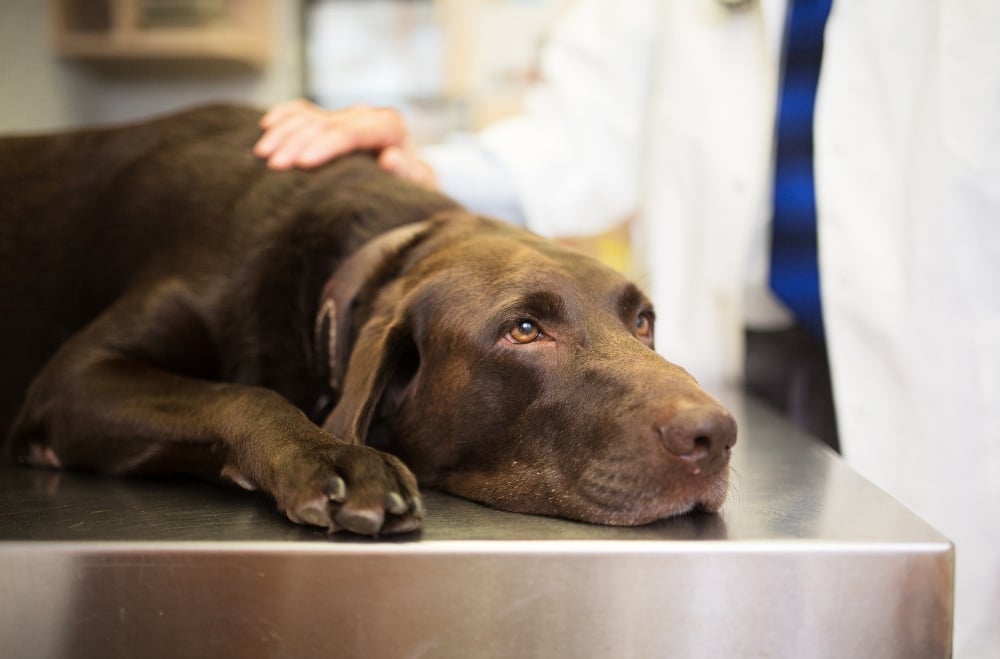Key Takeaways
- You can make homemade dog food with human foods, but it must have the right balance of proteins, fats, carbohydrates, vitamins, and minerals to be healthy.
- Vets generally don’t recommend making your own raw dog food because of the risk of bacterial contamination or possible public health risks.
- Consult with a vet or veterinary nutritionist to make sure a homemade diet works for your pet.
Table of Contents
For dog owners, it’s only natural that you question what’s in your pup’s food. Sure, it says “chicken” on the bag, but what does that actually mean? If you’ve been questioning store-bought food, or would just rather have more control over your dog’s diet, there are homemade options that can meet your dog’s nutritional requirements. Your vet can steer you in the right direction for preparing homemade dog diets, and you should always ask about the suitability of a particular veterinary-endorsed diet for your dog.
The Benefits of Homemade Dog Food
Making your dog’s food at home may offer some benefits over commercially available diets. If you’re making your dog’s meals yourself, you have the freedom to purchase the freshest, highest-quality ingredients available. Home cooking can also be a good option for dogs with food allergies or other dietary sensitivities. When you know what ingredients your dog reacts to, it’s simple enough to avoid them. Dogs who struggle to eat enough food (because of illness or extreme pickiness) may eat more of a homemade diet. Dry kibble tends to be the least appealing to dogs. Wet foods are better, but a homemade diet can prove to be truly irresistible.
Before You Start Cooking: Homemade Dog Food Needs to be Balanced
Your homemade meal should contain protein, fat, carbohydrates, vitamins, and minerals. Make sure you weigh your dog frequently to verify they stay a healthy weight. Take your dog to the vet before starting the homemade diet so your vet can determine your dog’s ideal weight and you can discuss what recipes are appropriate for your dog.
Protein
When a dog eats protein, their body breaks it down into its building blocks called amino acids, which are then reassembled into the proteins they need. Proteins play many roles in a dog’s body, including:
- Building and maintaining muscle, skin, hair, nails, tendons, ligaments, and cartilage
- Producing enzymes, hormones, and disease-fighting antibodies
- Acting as a source of specific nutrients, like nitrogen, that are used to make other molecules
The Association of American Feed Control Officials (AAFCO) puts together standards for dog food. The AAFCO minimum protein percentage for dog food is 22.5% for puppies and 18% for adults and seniors on a dry matter basis. Reporting nutrient percentages on a dry matter basis takes into account the differing amounts of water present in various types of dog food (canned versus kibble, for example).
Fats
Fats in the diet are an excellent source of energy and make food taste good. Essential fatty acids play important roles in the body and have to be present in the diet because a dog’s body can’t make them from other substances. For example, omega-3 fatty acids, like those present in cold-water fish oils, can reduce inflammation.
The AAFCO crude fat minimum percentage on a dry matter basis for puppy foods is 8.5% and for adult and senior dogs it is 5.5%.
Carbs
Carbohydrates aren’t an essential part of a dog’s diet, but they still can have many important roles such as:
- Providing energy
- Reducing the need for protein to be used as an energy source (freeing it up to be available for its other roles)
- Promoting normal gastrointestinal function (especially fiber)
- Supplying specific nutrients that can be used to make other molecules
AAFCO does not set standards for the amount of carbohydrate in dog foods since it is not considered an essential nutrient.
Vitamins and Minerals
Only small amounts of vitamins and minerals need to be provided in a dog’s diet, but without them, dogs can quickly become very sick. To make things even more complicated, too much of certain vitamins and minerals can be just as dangerous as too little.
Now let’s look at some vet-approved homemade dog food recipes that provide a good balance or proteins, fats, carbohydrates, vitamins, and minerals.
Vet-Approved Recipe #1:
Massachusetts’ MSCPA-Angell Animal Medical Center provides sample recipes on its website for dogs weighing 15, 30 and 60 pounds.
For a 15-pound dog:
- 3 ounces of chicken, dark meat, cooked
- 1 1/3 cups of white rice, cooked
- 1 tablespoon of mixed vegetables, cooked
- 1 to 2 teaspoons of vegetable oil
- 1.5 black scoops Balance IT Canine vitamin, mineral, and amino acid supplement
For a 30-pound dog:
- 4.5 ounces of chicken, dark meat, cooked
- 2 cups of white rice, cooked
- 1.5 tablespoons of mixed vegetables, cooked
- 2 to 3 teaspoons of vegetable oil
- 2.5 black scoops Balance IT Canine vitamin, mineral, and amino acid supplement
For 60-pound dogs:
- 8 ounces of ounces of chicken, dark meat, cooked
- 3.5 cups of white rice, cooked
- 3 tablespoons of mixed vegetables, cooked
- 3 to 5 teaspoons of vegetable oil
- 4.5 black scoops Balance IT Canine
Directions
- All proteins, carbohydrates, and vegetables should be thoroughly cooked, allowed to cool, and then weighed.
- Combine all ingredients and mix them together well. Make sure the supplements are mixed thoroughly throughout the food.
- This recipe provides one day’s worth of food. It can be prepared in the morning, divided into multiple portions for the day, and refrigerated until mealtime.
MSPCA-Angell AMC notes that the supplement, Balance IT® Canine, mentioned in these recipes is not optional. Leaving it out will produce a diet that has many nutritional deficiencies
Vet-Approved Recipe #2:
Founder’s Veterinary Clinic of Brea, California, offers a sample recipe for 20-pound dogs that you can half for 10-pounders or double for 40-pound canines.
For a 20-pound dog:
- 1/4 pound of cooked, skinless chicken
- 1 cup of cooked brown rice
- ½ to 1 cup of peas and carrots
- 1 tablespoon of vegetable oil (they recommend Udo’s Oil 3-6-9 Blend)
- 1/4 teaspoon of potassium chloride (a salt substitute).
- 250 mg calcium citrate
- Daily multiple vitamin/mineral supplement (either a vet-recommended supplement or ¼ of a human adult dose)
Allowed substitutions for this recipe include boned fish, lean ground turkey, beef, or lamb as a protein source and potatoes, yams, or pasta as a carbohydrate. As always, the supplements mentioned in this diet are not optional.
Directions
- All proteins, carbohydrates, and vegetables should be thoroughly cooked, allowed to cool, and then weighed.
- Combine all ingredients and mix them together well. Make sure the supplements are mixed thoroughly throughout the food.
- This recipe provides one day’s worth of food. It can be prepared in the morning, divided into multiple portions for the day, and refrigerated until mealtime.
Vet-Approved Recipe #3:
The following recipe was created by Balance.it, for a 9 year old, spayed female dog who weighs 50 pounds. The Balance.it recipe generation tool allows pet parents to create nutritionally complete homemade dog foods for healthy pets using ingredients of your choice.
For a 50-pound dog
- 13 7/8 oz chicken breast, skinless, boneless, cooked, roasted
- 5 ¼ teaspoons canola oil
- 1 3/10 mL Nordic Naturals Omega-3 Pet Liquid
- 1 ½ cups sweet potato, cooked, baked in skin, without salt, flesh fed only
- 3/4 cup spinach, cooked, boiled, drained, without salt
- 11/16 teaspoon Morton iodized salt
- 5 teaspoons Balance IT® Canine (2.5 g/tsp)
Directions
- All proteins, carbohydrates, and vegetables should be thoroughly cooked, allowed to cool, and then weighed.
- Combine all ingredients and mix them together well. Make sure the supplements are mixed thoroughly throughout the food.
- This recipe provides one day’s worth of food. It can be prepared in the morning, divided into multiple portions for the day, and refrigerated until mealtime.
The Balance.it generator will also produce recipes that use human vitamin and mineral supplements rather than Balance IT® Canine, but they contain many more ingredients and are harder to prepare accurately.
What About Raw-Diet Foods?
Gaining popularity is the raw food diet, also known as the Biologically Appropriate Raw Food, or BARF, diet. The concept was developed by an Australian veterinarian, Dr. Ian Billinghurst. BARF’s philosophy states that “the diet a dog evolved to eat — over many millions of years of evolution — is the best way to feed it.” While you might find some veterinarians recommending homemade raw foods for dogs, similar to what ancient canines ate, that’s not the view of the American Veterinary Medical Association. The AVMA, along with the U.S. Food and Drug Administration Center for Veterinary Medicine and the U.S. Centers for Disease Control and Prevention, don’t recommend raw dog food, in part because of the risk of bacterial contamination or possible public health risks.
Always Get Your Vet’s Approval
If your dog suffers from medical issues, you will need to adjust certain veterinary-endorsed diets. Ask your own vet about your dog’s specific nutritional needs as well as for a recommendation for a certified veterinary nutritionist. The three of you can find a homemade diet that meets your pup’s dietary requirements. Whether your dog has specific medical problems or not, you should always tell your vet that your dog eats a homemade diet because they will need to see your dog more frequently to continue to evaluate the diet and to monitor for nutrition-related health problems.
Frequently Asked Questions
Start by focusing on the protein source in your homemade dog food. Human-grade beef, chicken, turkey, egg, lamb, fish, rabbit, and tofu are all good options. Then round out your recipe with healthy fats and carbohydrates (vegetable oil and brown rice, for example) and vitamin and mineral supplements.
It is not easy to prepare a healthy homemade dog food that is safe for long-term feeding. Therefore, most vets recommend that pet parents feed high-quality, commercially available dog foods instead.
Many grains can be included in healthy homemade dog food. Good options include barley, pasta, millet, oats, potato, sweet potato, white rice, and brown rice.
Do not include the following ingredients in homemade dog food as they can cause health problems: chocolate, macadamia nuts, grapes, raisins, xylitol (a sugar substitute), onions, garlic, chives, cooked bones that haven’t been ground up, and raw bones, meat, fish or egg.
Healthy homemade dog foods include proteins, fats, carbohydrates, vitamins, and minerals.








